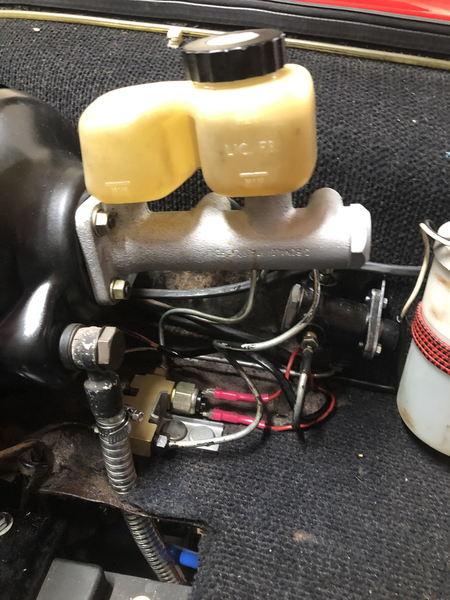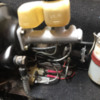I am almost reluctant to post on this subject. But I have read all the previous posts on brakes and brake bleeding and am running out of ideas.
6997 had been sitting for 30 years before the rebuild.
I have fully rebuilt all of the brakes on 6997 . All the calipers are rebuilt , standard, with new seals and pads ex Halls , all installed no leaks. All new Goodrich flexible braided lines . All bleeders have been assembled with gas tight seal tape.
The master has had a Halls seal rebuild kit put into it and it was rebuilt including re-sleeving by a local brake shop who has credibility. Mind you I think it held a few challenges for them.
All the ancillaries items are are new. The pressure differential and pressure regulator assemblies are out of the box Wilkinson sourced. The old ones were paperweights.
I bench bled the master on the bench and then via releasing the tube couplings once it was in the car - and noted allot more flow pulsing from the rear outlet for the front brakes than the front outlet for the rear brakes but ploughed ahead anyway.
I had one try to bleed the system and finally realized the internal plunger must not have been adjusted inside the master when the shop rebuilt it. Dumb. I disassembled the master and adjusted the plunger point forward almost 1/2 inch to give it around 0.30 thou clearance but was almost out of adjustment on the piston plunger thread at the end . I re-bench bled the master and reinstalled the master cylinder again noting only low flow from the front port.
I have now run what appears to be the forum standard gallon of brake fluid through the system and bled from the shortest to the longest runs multiple times, using both traditional pumping and vacuum bleeding techniques. I am getting no residual bubbles at all from any of the bleed points but allot more flow from the front bleeders during traditional pumping. There is flow from the back bleeders but at about half the front volume. No Bubbles at any point.
The pedal feel still feels spongy at the top - not the rock hard solid feel I would have expected. There is a hard pedal close to the floor .
My questions - am I missing something on the rear brakes or the master cylinder bleeding or adjustments . Is it possible there still residual air in the master rear brake front piston after liters of BF through the rear brakes?
Any other points of adjustment that I may have missed ? Any common mistakes on the master rebuild that may have occurred?
Any other suggestions on what to check next or other actions that might help would be very gratefully received.



